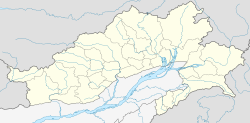Dhola post
Che Dong | |
|---|---|
Border post | |
| Coordinates: 27°49′05″N 91°40′25″E / 27.81806°N 91.67361°E | |
| Country | India (claimed by China) |
| Province | Arunachal Pradesh |
Dhola Post was a border post set up by the Indian Army in June 1962, at a location called Che Dong (Chinese: 扯冬; pinyin: Chě dōng), in the Namka Chu river valley area disputed by China and India. The area is now generally accepted to be north of the McMahon Line as drawn on the treaty map of 1914, but it was to the south of the Thagla Ridge, where India held the McMahon Line to lie.[1][2][3] On 20 September 1962, amidst various border tensions, the post was attacked by Chinese forces from the Thagla Ridge, and sporadic fighting continued till 20 October when an all-out attack was launched by China leading to the Sino-Indian War. Facing an overwhelming force, the Indian Army evacuated the Dhola Post as well as the entire area of Tawang, retreating to Sela and Bomdila.[4] After the war, the post was left unoccupied until the 1986 Sumdorong Chu standoff, after which the area was again strengthened by the Indian Army.
- ^ Hoffmann, India and the China Crisis (1990), pp. 108–110: "[Mahabir] Prasad raised the whole issue with Palit and gave him army maps on which a straight-line border ran from Khinzemane to Bhutan, well south of the Dhola post... During the officials' talks the Chinese had also been told of the Indian view on correcting a map-drawn line; that is, the need to correlate it with the actual features on the ground. If a feature such as Thagla Ridge had not been explored when the map was issued, and if the map-drawn boundary was supposed to be set by the watershed ridge, then the line lay on the watershed ridge despite the error on the map."
- ^ Raghavan, War and Peace in Modern India (2010), p. 295: "According to the treaty map of 1914 the McMahon Line ran south of the Thagla ridge."
- ^ Van Eekelen, Indian Foreign Policy and the Border Dispute (1967), p. 114: "Che Dong or Dhola was south of the Thagla ridge which, being the watershed, was identified with the McMahon Line by the Indian side.... China moved south to demonstrate her claim and did so at a point where there could be a discrepancy between the McMahon Line as shown on the map of 1914 and that indicated by the watershed.... China knew that India regarded the Thagla ridge as the border."
- ^ Raghavan, War and Peace in Modern India (2010), pp. 296–305.

